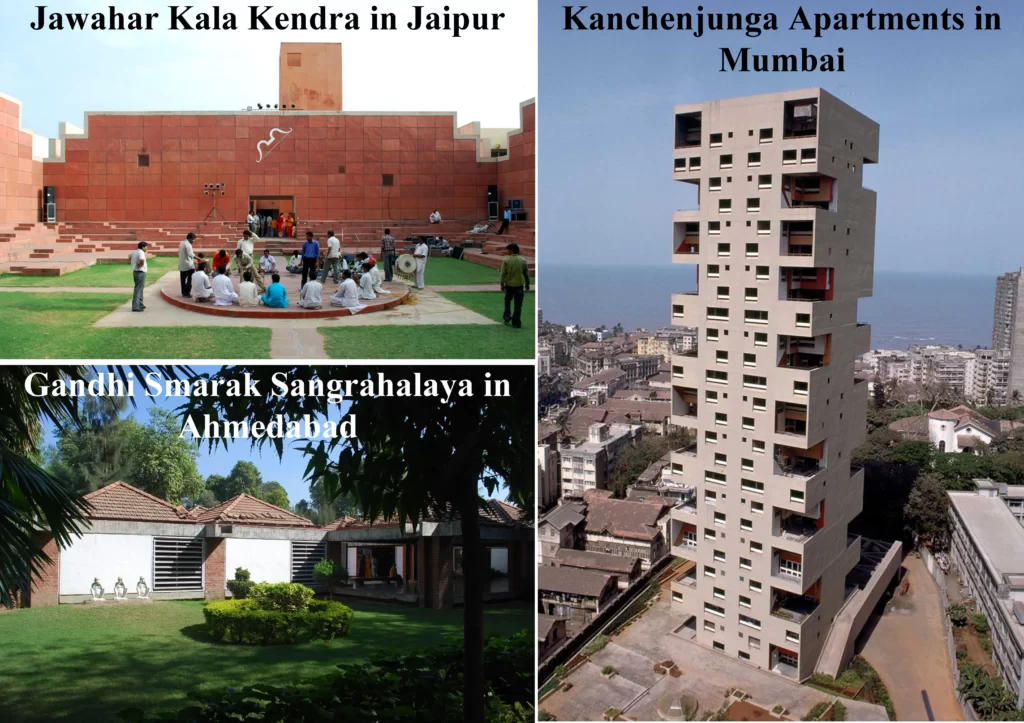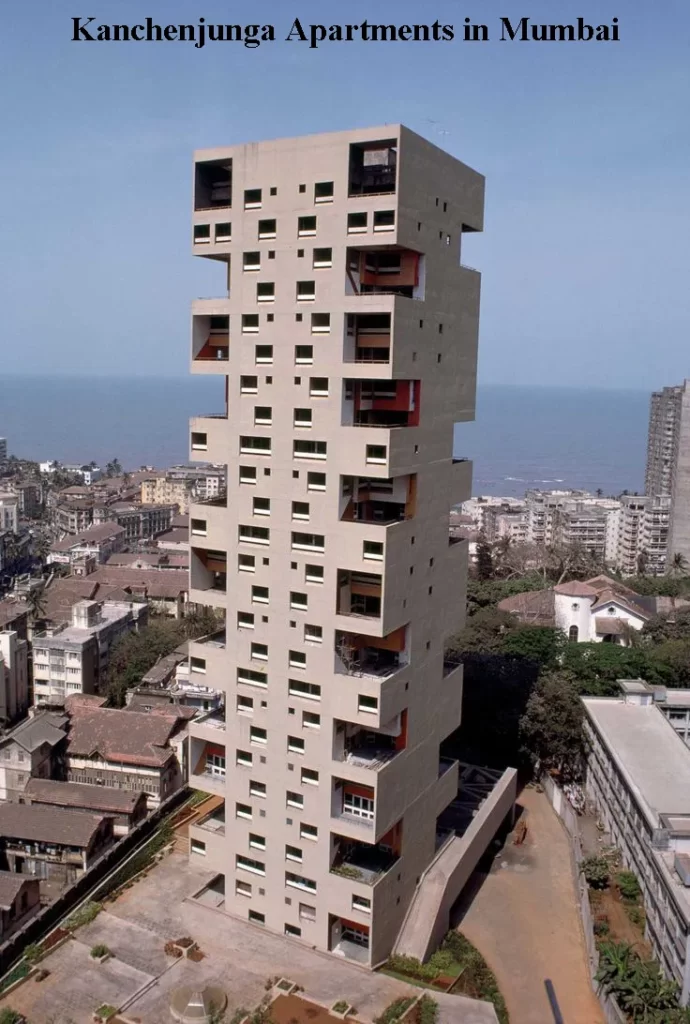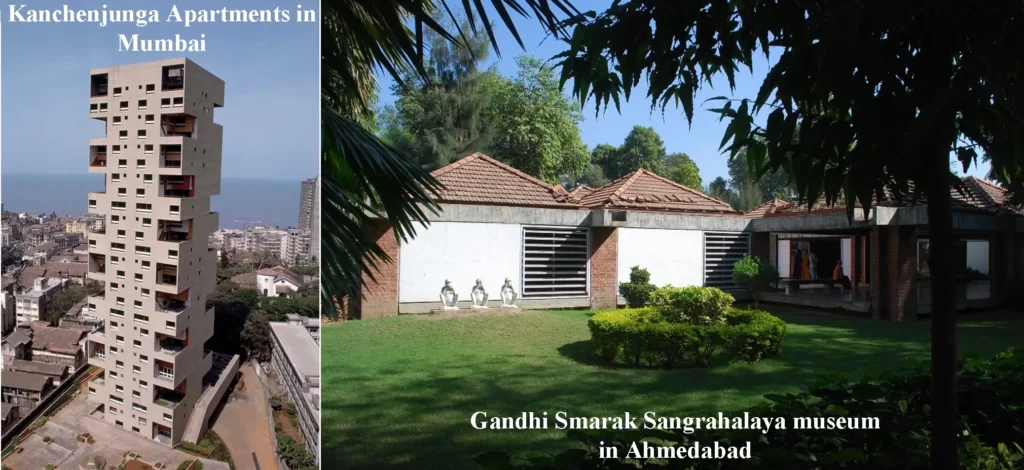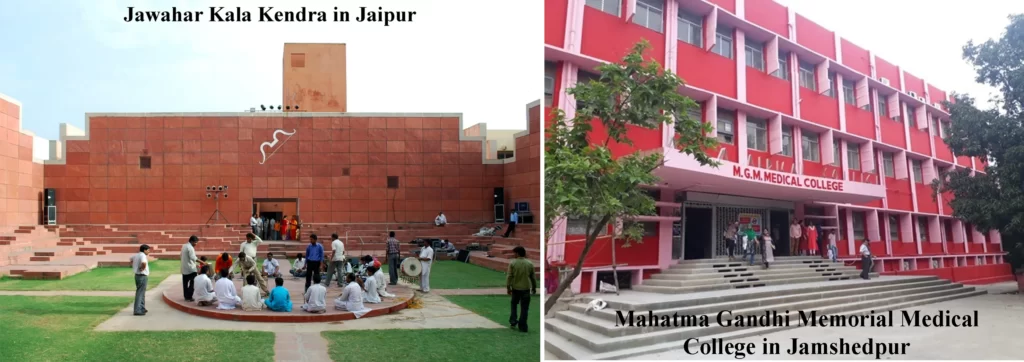Charles Correa was a renowned Indian architect, planner, and activist who played a significant role in shaping modern Indian architecture. He was born in 1930 in Secunderabad, India, and passed away in 2015.
Correa’s contributions to architecture were focused on creating sustainable, socially responsible designs that were rooted in Indian culture and identity. He believed in designing structures that responded to the needs and aspirations of the people who used them, and his work reflected a deep understanding of the complex cultural, environmental, and social factors that shaped Indian society.

If you want to know about the charles correa or staircase design or landscape garden, please click the link.
Correa’s notable works include the Jawahar Kala Kendra in Jaipur, the Kanchenjunga Apartments in Mumbai, and the Gandhi Smarak Sangrahalaya in Ahmedabad. His designs were marked by a unique blend of modernist principles and traditional Indian elements, resulting in structures that were both functional and aesthetically pleasing.

Learning about Correa’s work is important because it helps us appreciate the rich architectural heritage of India and the unique challenges and opportunities that shape the field of architecture in the country. It also provides insights into how architecture can be used to address social and environmental issues, and how a deep understanding of local culture and traditions can inform and enrich the design process.
1) Early Life and Education
Charles Correa was born on September 1, 1930, in Secunderabad, India. His parents were of Goan origin, and his father was a prosperous merchant. Correa grew up in a multicultural and multilingual environment, speaking English, Hindi, Marathi, and Portuguese.
i) Education and training in architecture:
Correa earned a degree in architecture from the University of Michigan in 1953. He then studied urban design at the Massachusetts Institute of Technology (MIT), where he earned a master’s degree in architecture and urban design in 1955. After completing his studies, he returned to India and started his own architectural practice in Mumbai.
ii) Influences and inspirations:
Correa’s work was influenced by a variety of factors, including his upbringing in a multicultural environment, his education and training in the US, and his exposure to traditional Indian architecture and culture. Some of his major influences and inspirations include:
- Le Corbusier: Correa was greatly influenced by the work of Swiss-French architect Le Corbusier, whom he had the opportunity to meet while studying at MIT. Corbusier’s ideas about modernism, functionality, and urban planning had a lasting impact on Correa’s own work.
- Traditional Indian architecture: Correa was also deeply influenced by traditional Indian architecture, particularly the principles of Vastu Shastra, which is the traditional Hindu system of architecture. He believed in incorporating traditional Indian elements into his designs, such as courtyards, verandas, and shading devices, to create structures that were both functional and culturally appropriate.
- Social and environmental issues: Correa’s work was also shaped by his concern for social and environmental issues, such as urbanization, poverty, and sustainability. He believed in using architecture as a tool for social and economic development, and his designs reflected this commitment to creating socially responsible structures that responded to the needs of the people who used them.
2) Career and Achievements
i) Overview of Correa’s notable works and projects:
Charles Correa designed numerous notable works throughout his career, including:
- Jawahar Kala Kendra in Jaipur, India
- Kanchenjunga Apartments in Mumbai, India
- National Crafts Museum in New Delhi, India
- Bharat Bhavan in Bhopal, India
- Champalimaud Centre for the Unknown in Lisbon, Portugal
- Mahatma Gandhi Sangrahalaya (Gandhi Museum) in Ahmedabad, India
- British Council building in New Delhi, India
- Brain Science Center at MIT in Cambridge, Massachusetts
These projects reflect Correa’s commitment to creating functional, socially responsible structures that responded to the needs of their users. Many of his designs incorporate traditional Indian elements, such as courtyards, verandas, and shading devices, while also incorporating modernist principles such as flexibility, adaptability, and sustainability.
ii) Awards and recognitions received:
Correa received numerous awards and recognitions throughout his career, including:
- Padma Shri in 1972 and Padma Vibhushan in 2006, two of India’s highest civilian awards
- Royal Gold Medal from the Royal Institute of British Architects in 1984
- Aga Khan Award for Architecture in 1988 for the Kanchenjunga Apartments
- Praemium Imperiale from the Japan Art Association in 1994
- Lifetime Achievement Award from the Indian Institute of Architects in 2001
iii) Contributions to the field of architecture:
Correa’s contributions to the field of architecture were significant and enduring. He believed in using architecture as a tool for social and economic development, and his designs reflected this commitment.
He also believed in incorporating traditional Indian elements into his designs, while also embracing modernist principles such as functionality, flexibility, and sustainability. Correa’s work has influenced countless architects and designers, both in India and around the world, and his legacy continues to shape the field of architecture today.
3) Design Philosophy and Style
i) Correa’s design philosophy and principles:
Charles Correa’s design philosophy was shaped by his belief in creating structures that were both functional and socially responsible. He believed in using architecture as a tool for social and economic development, and his designs reflected this commitment. Some of his key design principles include:
- Sustainability: Correa believed in designing structures that were environmentally sustainable, incorporating features such as natural ventilation, shading devices, and green spaces.
- Flexibility: Correa’s designs were flexible and adaptable, allowing them to be easily modified and re-purposed as needed.
- Traditional Indian elements: Correa incorporated traditional Indian elements into his designs, such as courtyards, verandas, and shading devices, to create structures that were both functional and culturally appropriate.
- Modernist principles: Correa also embraced modernist principles such as functionality, adaptability, and efficiency, resulting in structures that were both aesthetically pleasing and technologically advanced.
ii) Description of his unique style and aesthetic:
Correa’s unique style and aesthetic were marked by a blend of traditional Indian elements and modernist principles. His designs often incorporated features such as courtyards, verandas, and shading devices, which were rooted in traditional Indian architecture.
At the same time, he embraced modernist principles such as functionality, adaptability, and sustainability, resulting in structures that were both functional and aesthetically pleasing. Correa’s designs were also marked by their use of simple, clean lines and a focus on natural light and ventilation.
iii) How his work reflects Indian culture and identity:
Correa’s work reflects Indian culture and identity in several ways. His use of traditional Indian elements such as courtyards, verandas, and shading devices reflects a deep understanding of Indian architecture and culture.
At the same time, his designs incorporate modernist principles such as functionality and sustainability, reflecting India’s position as a rapidly developing country with a growing economy.
Correa’s work also reflects India’s diverse and multicultural society, incorporating elements from a variety of Indian traditions and cultures. Overall, Correa’s work reflects a deep appreciation for India’s rich cultural heritage and a commitment to using architecture as a tool for social and economic development.
4) Major Works
i) Jawahar Kala Kendra in Jaipur:
The Jawahar Kala Kendra is a cultural center located in Jaipur, India, designed by Charles Correa in 1986. The complex consists of several buildings arranged around a central courtyard, and includes exhibition spaces, theaters, and an amphitheater.
The design of the complex is based on traditional Indian concepts of space and form, including the use of courtyards, verandas, and shading devices. The buildings are arranged around a series of interconnected courtyards, which are designed to provide natural light and ventilation while also creating a sense of community and connection between different parts of the complex.

The design of the Jawahar Kala Kendra reflects Correa’s commitment to creating structures that are both functional and socially responsible. The complex incorporates sustainable features such as natural ventilation and shading devices, and is designed to be adaptable and flexible, allowing it to be easily modified and re-purposed as needed.
The Jawahar Kala Kendra has had a significant impact on the cultural life of Jaipur and the surrounding region, providing a venue for a wide range of cultural activities and events.
ii) Kanchenjunga Apartments in Mumbai:
The Kanchenjunga Apartments is a residential complex located in Mumbai, India, designed by Charles Correa in 1970. The complex consists of three towers arranged around a central courtyard, and includes 32 apartments in total.
The design of the complex is based on traditional Indian concepts of space and form, including the use of courtyards, verandas, and shading devices. The towers are arranged in a stepped formation, with each floor set back slightly from the one below, allowing for natural light and ventilation.

The design of the Kanchenjunga Apartments reflects Correa’s commitment to creating structures that are both functional and socially responsible. The complex incorporates sustainable features such as natural ventilation and shading devices, and is designed to be adaptable and flexible, allowing it to be easily modified and re-purposed as needed.
The Kanchenjunga Apartments have had a significant impact on the design of residential buildings in India, inspiring a new generation of architects to incorporate traditional Indian elements into their designs.
iii) Bharat Bhavan in Bhopal:
Bharat Bhavan is a multi-disciplinary arts center located in Bhopal, India, designed by Charles Correa in 1982. The complex includes exhibition spaces, theaters, a library, and an art gallery, and is designed to promote the arts and culture of India.
The design of the complex is based on traditional Indian concepts of space and form, including the use of courtyards, verandas, and shading devices. The buildings are arranged around a series of interconnected courtyards, which are designed to provide natural light and ventilation while also creating a sense of community and connection between different parts of the complex.

The design of Bharat Bhavan reflects Correa’s commitment to creating structures that are both functional and socially responsible. The complex incorporates sustainable features such as natural ventilation and shading devices, and is designed to be adaptable and flexible, allowing it to be easily modified and re-purposed as needed.
Bharat Bhavan has had a significant impact on the cultural life of Bhopal and the surrounding region, providing a venue for a wide range of cultural activities and events.
Importance and impact of each work
Each of these works reflects Charles Correa’s unique design philosophy and principles, incorporating traditional Indian elements while also embracing modernist principles such as functionality and sustainability. These works have had a significant impact on the field of architecture in India and around the world, inspiring a new generation of architects to incorporate traditional Indian elements into their designs. They also reflect Correa’s commitment to using architecture
5) Social and Environmental Consciousness
Charles Correa was a committed advocate for sustainable architecture and responsible design, and his work reflected his concern for the environment and the well-being of society. He recognized that architecture had a crucial role to play in addressing pressing social and economic issues in India, including poverty, urbanization, and environmental degradation.
Correa’s commitment to sustainable architecture was evident in many of his projects. For example, the Kanchenjunga Apartments in Mumbai incorporated features such as rainwater harvesting and solar water heating, and the Gandhi Smarak Sangrahalaya museum in Ahmedabad was built using locally-sourced materials and was designed to be energy-efficient.

Correa was also committed to using architecture as a means to address social and community development issues. Many of his projects were focused on providing housing, education, and cultural facilities to disadvantaged communities.
For example, the Jawahar Kala Kendra arts center in Jaipur was designed to provide a space for cultural and artistic expression, and the Mahatma Gandhi Memorial Medical College in Jamshedpur was built to serve as a medical facility for underserved communities.

In addition to his work on individual projects, Correa also made significant efforts to address broader issues of urbanization and poverty in India. He was a vocal critic of urban sprawl and advocated for more sustainable and livable urban environments. He was also a proponent of participatory planning and community engagement in the design process, believing that this was essential for creating spaces that truly reflected the needs and aspirations of the people who would use them.
Overall, Charles Correa’s commitment to sustainable architecture and responsible design, as well as his efforts to address social and community development issues through architecture, have had a significant impact on the field of architecture in India and beyond. His legacy serves as a reminder of the important role that architecture can play in shaping society and promoting sustainable development.
6) Legacy and Impact
Charles Correa’s work continues to be influential and inspiring to architects today, both in India and around the world. His innovative approach to architecture, which emphasized a deep understanding of local cultural contexts and a commitment to sustainable design, continues to be relevant to contemporary architectural practice.
Correa’s role in shaping the architecture and urban planning discourse in India cannot be overstated. He was a key figure in the post-independence period when India was grappling with issues of national identity, economic development, and urbanization. Correa’s work was instrumental in defining a distinctly Indian architectural language that was grounded in local traditions and cultural contexts while also being forward-looking and modern.
Correa’s legacy is an important one, not only for the architecture profession but also for society at large. His work demonstrated the potential for architecture to be a force for social and economic development, as well as for environmental sustainability. His advocacy for community engagement and participatory planning has influenced many architects and urban planners, and his emphasis on sustainable design continues to be a pressing concern today.
It is important to preserve and study Correa’s legacy for several reasons. First, his work is an important part of India’s architectural and cultural heritage, and preserving it is essential for future generations to understand and appreciate the country’s rich architectural history.
Second, studying Correa’s work can provide valuable insights into contemporary architectural practice, particularly in the areas of sustainability, cultural context, and community engagement. Finally, Correa’s legacy serves as an inspiration and a challenge to architects today, reminding them of the potential for architecture to make a positive impact on society and the environment.
7) Conclusion
Charles Correa was a pioneering architect whose work had a profound impact on the field of architecture and Indian society as a whole. He was a committed advocate for sustainable architecture, responsible design, and community development, and his work reflected his deep understanding of local cultural contexts and his innovative approach to contemporary architectural practice.
Correa’s many achievements include the design of numerous iconic buildings and projects, including the Jawahar Kala Kendra in Jaipur, the Kanchenjunga Apartments in Mumbai, and the Mahatma Gandhi Memorial Medical College in Jamshedpur. He was also the recipient of many prestigious awards, including the Padma Shri, the RIBA Royal Gold Medal, and the Aga Khan Award for Architecture.
Correa’s contributions to the field of architecture and urban planning in India were far-reaching and profound. He helped to define a distinctly Indian architectural language that was grounded in local traditions and cultural contexts while also being forward-looking and modern. He was a vocal advocate for sustainable design, community engagement, and participatory planning, and his work continues to be an inspiration and a challenge to architects today.
Overall, Charles Correa’s impact on the field of architecture and Indian society as a whole was significant and lasting. His legacy serves as a reminder of the power of architecture to shape society and promote sustainable development, and his work continues to inspire architects and urban planners around the world.